Differentiate the following activities on the basis of voluntary (V)
involuntary (IV) muscles.
(a) Jumping of frog
(b) Pumping of the heart
(c) Writing with hand
(d) Movement of chocolate in your intestine
To differentiate the activities based on voluntary (V) and involuntary (IV) muscles, we can analyze each activity as follows:
1. Jumping of Frog:
- Analysis: Jumping is a deliberate action that requires conscious control. Frogs use their skeletal muscles to perform this action.
- Classification: This activity is Voluntary (V).
2. Pumping of the Heart:
- Analysis: The heart pumps blood automatically and is not under conscious control. It uses cardiac muscles, which are involuntary.
- Classification: This activity is Involuntary (IV).
3. Writing with Hand:
- Analysis: Writing is a controlled action that requires the use of skeletal muscles in the hands and arms. It is performed with conscious effort.
- Classification: This activity is Voluntary (V).
4. Movement of Chocolate in Your Intestine:
- Analysis: The movement of food through the intestines occurs automatically through the contraction and relaxation of smooth muscles, which are involuntary.
- Classification: This activity is Involuntary (IV).
Final Classification:
- (a) Jumping of frog: Voluntary (V)
- (b) Pumping of the heart: Involuntary (IV)
- (c) Writing with hand: Voluntary (V)
- (d) Movement of chocolate in your intestine: Involuntary (IV)
---
- Analysis: Jumping is a deliberate action that requires conscious control. Frogs use their skeletal muscles to perform this action.
- Classification: This activity is Voluntary (V).
- Analysis: The heart pumps blood automatically and is not under conscious control. It uses cardiac muscles, which are involuntary.
- Classification: This activity is Involuntary (IV).
- Analysis: Writing is a controlled action that requires the use of skeletal muscles in the hands and arms. It is performed with conscious effort.
- Classification: This activity is Voluntary (V).
- Analysis: The movement of food through the intestines occurs automatically through the contraction and relaxation of smooth muscles, which are involuntary.
- Classification: This activity is Involuntary (IV).
- (a) Jumping of frog: Voluntary (V)
- (b) Pumping of the heart: Involuntary (IV)
- (c) Writing with hand: Voluntary (V)
- (d) Movement of chocolate in your intestine: Involuntary (IV)
Topper's Solved these Questions
- TISSUESBOOK - NCERT EXEMPLAR ENGLISHCHAPTER - TISSUESEXERCISE - Fill in the blanks
2 Videos
- TISSUESBOOK - NCERT EXEMPLAR ENGLISHCHAPTER - TISSUESEXERCISE - Long answer
9 Videos
- TISSUESBOOK - NCERT EXEMPLAR ENGLISHCHAPTER - TISSUESEXERCISE - Match the following
3 Videos
- THE FUNDAMENTAL UNIT OF LIFE BOOK - NCERT EXEMPLAR ENGLISHCHAPTER - THE FUNDAMENTAL UNIT OF LIFE EXERCISE - Long Answer Type Questions
7 Videos
- WHY DO WE FALL ILL BOOK - NCERT EXEMPLAR ENGLISHCHAPTER - WHY DO WE FALL ILL EXERCISE - Long Answer Type Questions
10 Videos
Similar Questions
Cardiac muscles are
(a) striated (b) nonstriated
(c) voluntary (d) involuntary
View Solution(a) Differentiate between three segments of a transistor on the basis of their size and level of doping.
(b) How is a transistor biased to be in active state?
(c) With the help of a necessary circuit diagram, describe briefly how n-p-n transistor in CE configuration amplifies a small sinusoidal input voltage. Write the expression for the ac current gain.
View SolutionArrector pili muscles are
(a) Voluntary, multiunit
(b) Involuntary, multiunit
(c) Involuntary, single unit
(d) Voluntary, single unit
View SolutionA cycle followed by an engine (made of one mole of perfect gas in a cylinder with a piston) is shown in figure.

A to B volume constant, B to C adiabatic, C to D volume constant and D to A adiabatic
VC=VD=2VA=2VB
(a) In which part of the cycle heat is supplied to the engine form outside?
(b) In which part of the cycle heat is being given to the surrounding by the engine ?
(c ) What is the work done by the engine in one cycle ? Write your answer in term of pA,pB,VA ?
(d) What is the efficiency of the engine ?
(γ=53 for the gas), (CV=32R for one mole )
View SolutionAssertion:−Visceral muscles do not exhibit any striation and are smooth in appearance.
Reason :− Their activities are not under the voluntary control of nervous system.
(a) If both Assertion & Reason are True & the Reason is a correct explanation of the Assertion .
(b) If both Assertion & Reason are True but Reason is not a correct explanation of the Assertion
(c) If Assertion is True but the Reason is False.
(d) If both Assertion & Reason are false.
View SolutionRead the following stetements (i−iv) and accordingly
mark the option that has both statements .
(i) The Cardiac fiber are branched with one or more nuclei.
(ii) The Striated muscles can be branched or unbranched
(iii) The involuntary muscles are non-striated
(iv) The Smooth muscles are unbranched and cylindrical
(a) i and iii
(b) ii and iv
(c) ii and iii
(d) i and ii
View SolutionSalts A, B, C, D and E undergo reactions (i) to (v) respectively. Identify the anion present in these salts on the basis of these reactions. Tabulate your answers in the format given below:
(i) When silver nitrate solution is added to a solution of A, a white precipitate, insoluble in dilute nitric acid, is formed.
(ii) Addition of dilute hydrochloric acid to B produces a gas which turns lead acetate paper black.
(iii) When a freshly prepared solution of ferrous sulphate is added to a solution of C and concentrated sulphuric acid is gently poured from the side of the test-tube, a brown ring is formed.
(iv) When dilute sulphuric acid is added to D a gas is produced which turns acidified potassium dichromate solution from orange to green.
(v) Addition of dilute hydrochloric acid to E produces an effervescence. The gas produced turns lime water milky but does not affect acidified potassium dichromate solution.

View SolutionThe diagram given below is a representation of a phenomenon pertaining to the nervous system. Study the diagram and answer the following questions:

(i) Name the phenomenon that is being depicted.
(ii) Give the technical term for the point of contact between the two nerve cells.
(iii) Name the parts A, B, C and D.
(iv) Write the functions of parts E and F.
(v) How does the arrangement of neurons in the spinal cord differ from that of the brain.
View SolutionAnswer question numbers 3(a) - 3(d) on the basis of your understanding of the following paragraph and the related studied concepts:
Around the year 1800, only 30 elements were known. Dobereiner in 1817 and Newlands in 1866 tried to arrange the then known elements and framed laws which were rejected by the scientists. Even after the ejection of the proposed laws, many scientists continued to search for a pattern that correlated the properties of elements with their atomic masses.
The main credit for classifying elements goes to Mendeleev for his most important contribution to the early development of a Periodic table of elements wherein he arranged the elements on the basis of their fundamental property, the atomic mass and also on the similarity of chemical properties. The formula of their hydrides and oxides were treated as basic criteria for the classification of the elements.
However, Mendeleev's classification also had some limitations as it could not assign the position to isotopes. He also left some gaps in the periodic table.
3(a) state Mendeleev's Periodic Law.
3(b) Why did Mendeleev leave some gaps in the Periodic table?
3(c) if the letter 'R' was used to represent any of the elements in the group , then the hydride and oxide of carbon would respectively be represented as
(i) RH4, RO
(ii) RH4, RO2
(iii) RH2, RO2
(iv) RH2, RO
3(d) isotopes are
(i) atoms of an element with similar chemical properties but different atomic masses.
(ii) atoms of different elements with similar chemical properties but different atomic masses.
(iii) atoms of an element with different chemical properties but same atomic masses.
(iv) atoms of different elements with different chemical properties but same atomic masses.
View SolutionWhich of the following statement are CORRECT?
I. Renin is a proteolytic enzyme found in gastric juice of infants which helps in the digestion of milk proteins.
II. No significant digestive activity occurs in the large intestine.
III. The egestion of faeces to the outside through the anal opening ( defecation ) is a voluntary process and is carried out by a mass peristaltic movement.
IV. Ejection of stomach contents through the mouth is a reflex action controlled by the vomiting center in the medulla.
(a) I, II and IV
(b) II, III and IV
(c) III and IV
(d) II and III
View Solution
